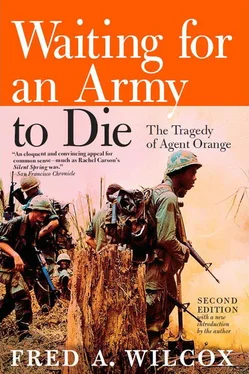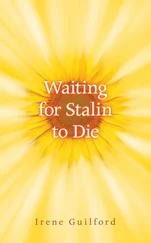Dr. Codario listened patiently for nearly three hours but, he confesses not without a considerable amount of skepticism. As a doctor he had been trained to perceive that certain causes produce readily identifiable effects, and nothing the veteran was telling him fit into this conceptual scheme. Still, he had an intuitive feeling that the man was more than a hypochondriac who, having run out of friends who would listen to his laments, had searched through the phone book until he found an MD.
During the course of a routine physical examination, Codario discovered that his patient’s liver was slightly enlarged and his blood pressure was high. He admitted him to the hospital, where further tests showed signs of liver inflammation, and a liver-spleen scan suggested sclerosis. A liver biopsy found fibrosis of the liver and fatty degeneration. These are the findings, says Codario, that one might expect in the tissue of someone who had been a heavy drinker, but also what one could expect to find in someone exposed to a toxic material. When asked if he used alcohol excessively, the veteran said that the use of alcohol and drugs was incompatible with martial arts training, and an examination of the biopsy failed to show the alcoholic hyalins that are usual in cases of alcoholic liver disease.
“So I simply told him,” Codario explains, “that he had been exposed to some type of toxic substance, but what it was I just didn’t know; and the most important thing was to make sure he didn’t expose himself to any further toxic substances. At the time he didn’t know anything about Agent Orange, and neither did I.”
During the next few months the veteran’s condition continued to deteriorate and, still unable to satisfactorily diagnose the source of his patient’s problems, Codario resorted to the explanation that, he now realizes, has been used all too often by VA and private physicians to dismiss the complaints of Vietnam veterans.
“At the time I was just unable to come up with answers, so, like most doctors who can’t make sense out of what a patient is saying, I suppose I resorted to thinking that maybe his physical symptoms were getting worse because of the stress he was under, maybe as the result of his combat experiences in Vietnam. There were times when I did wonder if some of his problems weren’t psychological.” But Codario’s initial gut reaction resisted this as being too easy, a facile, unsatisfactory solution. On one visit the veteran asked if Codario had ever considered the possibility that Agent Orange might be responsible for his problems.
“I said, ‘What’s Agent Orange?’” recalls Codario. “I thought it was something out of a McDonald’s hamburger ad or something. So he said, ‘It was a defoliant that was sprayed in Vietnam while I was there,’ I said that I thought it might be possible that a herbicide could cause liver damage, but that I really couldn’t say for sure. But I told him that it wouldn’t be unreasonable, considering the state he was in, for him to consider pursuing a claim for disability.”
Codario was unaware at the time that the Veterans Administration had been routinely denying disability to Vietnam veterans, even those who were nearly totally disabled from the effects of their exposure to toxic herbicides. He sent his patient to his own lawyer for legal advice, and after listening to the veteran’s story, Codario’s lawyer suggested he see another attorney who was working with Victor Yannacone on the class action suit against wartime manufacturers of Agent Orange. The attorney, Hy Mayerson, was so impressed by the fact that an MD would show so much interest in a Vietnam veteran that on the following day he forwarded more than a thousand pages of information on Agent Orange and the effects of dioxin on animals and humans to Codario’s office. Included in the material were approximately one hundred articles from toxicology journals dating back more than a decade, as well as data about where herbicides had been sprayed, what the effects of dioxin had been on animals and humans, and every accident in factories where herbicides were produced or dioxin was a contaminant of some chemical reaction.
Codario found the material fascinating. He read, for example, about a doctor in the Soviet Union who had examined four hundred workers in a herbicide factory over a ten-year period, describing symptoms that Codario would come across often during his examinations of Vietnam veterans: neurasthenia, headaches, loss of libido, personality changes, chloracne, and depression. A decade later researchers who had been studying fifty of the original four hundred workers found that 20 percent of them were suffering from porphyria cutanea tarda, an often-fatal stage of liver disease associated with exposure to TCDD-dioxin. Codario also read Lennart Hardell and M. Eriksson’s studies on the relationship between soft tissue sarcomas, malignant lymphomas, and exposure to chlorophenols and phenoxy acids, and he continued seeing veterans who seemed to have stepped from the pages of the material he was reading. Codario had wanted to believe that the Vietnam War was over, that the wounds of that era were at least beginning to heal, but he would discover that for many veterans the struggle for survival that began in mangrove forests, rice paddies, and jungles has not ended. And Codario would begin a war of his own—to save the lives of veterans poisoned by toxic herbicides.
One of the more intriguing things Codario came across during his research was that workers exposed to dioxin during industrial accidents often had in their urine elevated levels of a substance called “intermediate porphyrins.” Porphyrins, he knew, are substances that act as building blocks for hemoglobin—it takes four porphyrin molecules with an iron molecule in the center to make hemoglobin—and hemoglobin is similar structurally to chlorophyll, the material that enables plants to carry out photosynthesis. Because they are extremely sensitive to light, conditions for testing for porphyrins must be carefully controlled if the test is not to be invalidated by a change in their chemical structure.
Codario concluded that he needed expert advice if he was to find a way of analyzing the porphyrins in his patient’s urine, so he contacted Drs. Schwartz and Watson’s laboratory in Abbott Northwestern Hospital in Minneapolis, where a clinic had been established some years before to treat cases of porphyria. In the early 1970s researchers at the hospital had developed a “miracle drug” for treating patients with elevated porphyrins, and Codario was interested in the possibility of using this drug to help some of the veterans he had been seeing. After a brief correspondence, the clinic’s director, Dr. Petryka, agreed to organize the analysis of the veterans’ urine.
Codario collected urine specimens in special dark containers kept in an ice bath, and sent the containers to Philadelphia’s St. Joseph’s Hospital, where a registered nurse had volunteered to help out with the project. Upon receiving the containers, the nurse measured the exact amount in each container, then poured out 100 ccs for packing convenience, and, mixing it with a preserving chemical, shipped it via Federal Express to Minneapolis, where Dr. Petryka would then use thin-layer chromatography to analyze the specimens for elevated levels of porphyrins. Over the next few months, Codario examined 270 Vietnam veterans, performing urinalysis on 120 of them and discovering that the same unmistakable pattern appeared again and again.
“In fact,” he says, “ 68 percent of the people we’ve examined have an elevated level of one particular type of porphyrin in their urine, a type we call copro. In addition to the elevated level of coproporphyrins, 90 percent of the veterans I’ve examined have what we call a positive Ehrlich reaction. Now the Ehrlich reaction was a test that was done several years ago as a test for porphyrin problems. It is a reaction that takes place when a measured amount of urine is added to an acidified benzaldehyde solution. Before the advent of thin-layer chromatography and all the sophisticated methods of picking up the various types of porphyrins, it was a good screening test for picking up a particular type of porphyrin called porpho-bilinogen, which is an intermediate type of porphyrin. Dr. Petryka was the first person to actually describe a positive Ehrlich reaction in certain alcoholics because of the appearance of certain pyrroles in their urine.
Читать дальше











